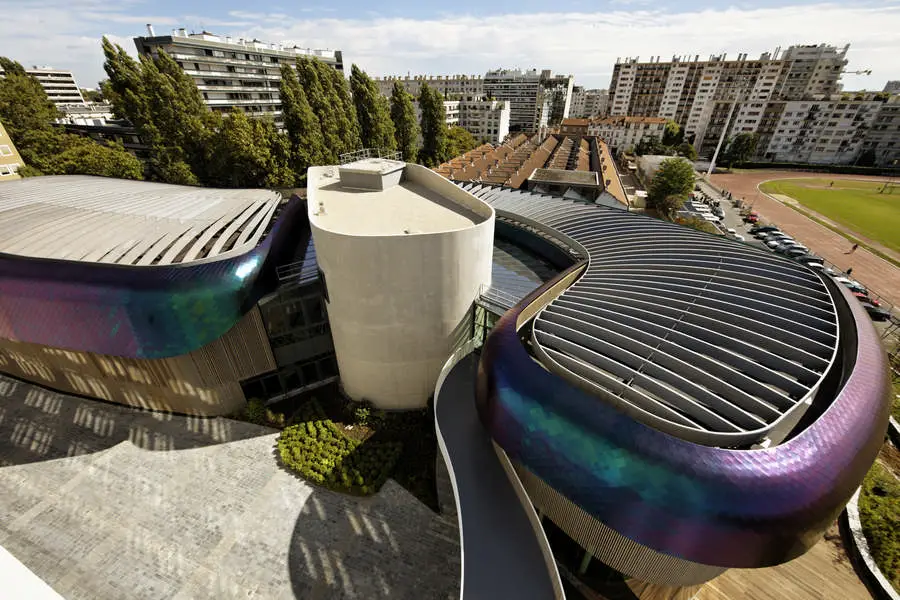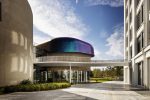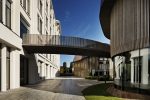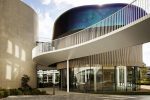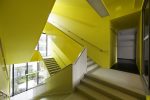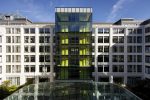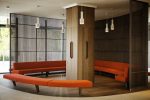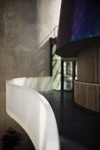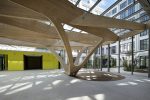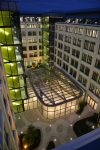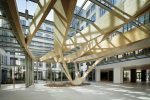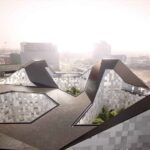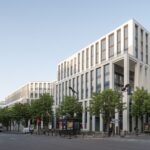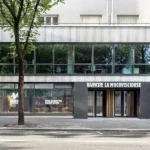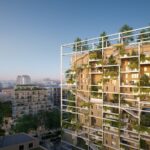IN / OUT Campus Boulogne-Billancourt, Société Foncière Lyonnaise Paris Building, Architect
IN / OUT Boulogne-Billancourt
New Building for Société Foncière Lyonnaise in south west Paris, France – design by DTACC / Agence Jouin Manku
29 Nov 2013
IN / OUT Boulogne-Billancourt Paris
an office « campus », for Société Foncière Lyonnaise
Design: DTACC and Agence Jouin Manku
An ambitious architectural project including THE TRANSFORMATION OF THE LOBBY WITH THE CONSTRUCTION OF A GLASS MIRCORARCHITECTURE as well as the creation of a new wing.
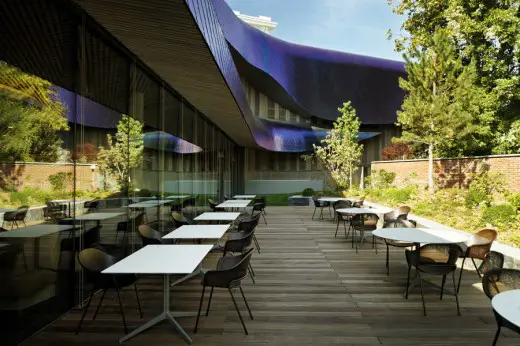
photo : Thierry Lewenberg-Sturm
80 YEARS OF HISTORY
Built in 1927 by the architect Adolphe Bocage, this building, a landmark of the golden age of industry, had long been used to produce telephone control units. Located on the banks of the Seine, the site, with nearly 7 acres and a 6-storey building, used to hold the LMT Society (Le Matériel Téléphonique). The building soon became a symbol of industrial innovation.
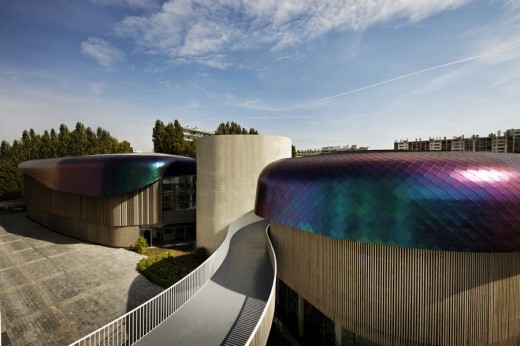
photo : Thierry Lewenberg-Sturm
The site had been designed in keeping with the great principles of the Modern Movement in architectureusing simple geometrical shapes, and reinforced concrete.
In 1976, Thomson-CSF took control over LMT, who, at the time, employed 10 000 people. In 1988, seventy years after its construction, Thomson Multimedia transformed the factory into offices and set up its head quarters in the building, until 2009.
SFL then decided to restructure the building, aiming for it to become a benchmark in the tertiary sector, focusing on innovation as well as on wellbeing at work. It is this ambitious decision that gave birth to the major IN/OUT project.
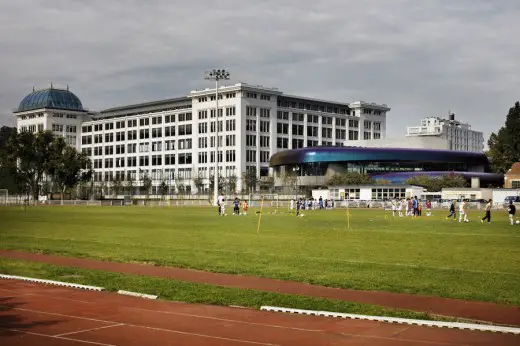
photo : Thierry Lewenberg-Sturm
THE SITE’S NEW ORGANIZATION
After our first commission to design a series of spaces for the Mandarin Oriental hotel in Paris, Société Foncière Lyonnaise (SFL), has asked us once again to embark on another adventure. This time, they have commissioned us to design a new amenities wing of their ambitious In/Out office campus, a landmark office project that is re-defining work spaces in France which houses a cafe, restaurant, board rooms, an auditorium as well as various technical spaces and the lobby, with his pavilion, of the historical building.
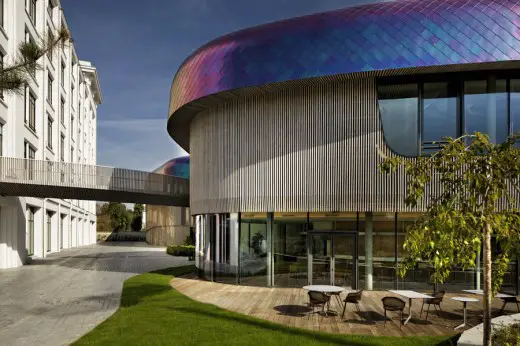
photo : Thierry Lewenberg-Sturm
The IN/OUT project involves an office « campus », of more than 387 500 square feet. It is located on a former industrial site in Boulogne, at the West of Paris, on the right bank of the Seine River. This factory, which used to manufacture telephone tools in the 1930s, underwent a complete rehabilitation done by DTACC Architecture, such as many industrial sites in Boulogne.
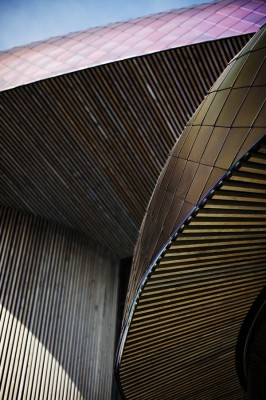
photo : Thierry Lewenberg-Sturm
Visitors enter the historical building and are welcomed into a large vast space similar to a hotel lobby. At the entrance lies a large oval desk the leads visitors to what used to be an exterior courtyard. In the courtyard one discovers a surprising micro-architecture: A glass pavilion that is held up by a series of intertwined and woven wood beams. An ethereal floating lattice which at one point swoops down and gently balances on the floor below on just one point. This new Glass canopy in the central courtyard, creates a natural transition between the lobby of the historical building and the amenities wing.
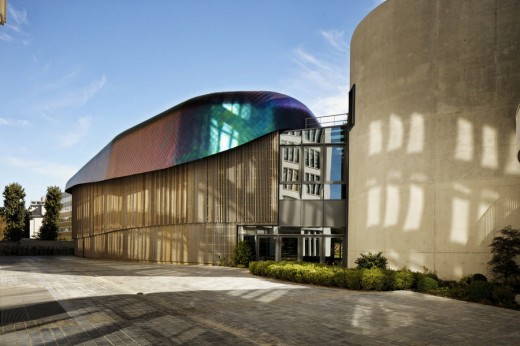
photo : Thierry Lewenberg-Sturm
This new amenities wing is nearly 40 000 sq ft.including the interiors. This building was further developed in collaboration with the engineering office TESS for the structural elements and the skin of the building and with architectural agency DTACC for the technical development and architectural execution.
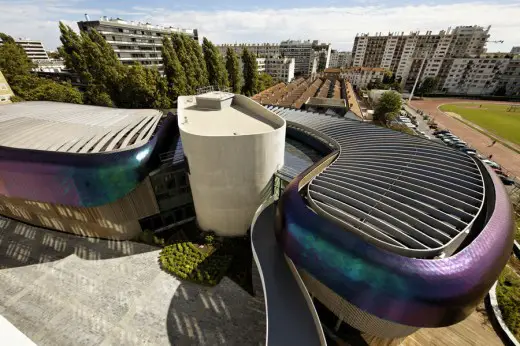
photo : Thierry Lewenberg-Sturm
THE amenities wing
Agence Jouin Manku has conceived the new amenities wing (nearly 40 000 sq ft.), as well as the interior design of the wing. The building has been further developed in collaboration with the engineering office TESS and DTACC. The new wing also holds a series of services and amenities, alongside the workspaces within the ‘Bocage’ building (thus completing the IN/OUT campus). The wing holds: a 103 seats cafe, a 462 seats restaurant, a 200 seats auditorium, as well as corporate board rooms, lounges, 2 large terraces and a fitness center.
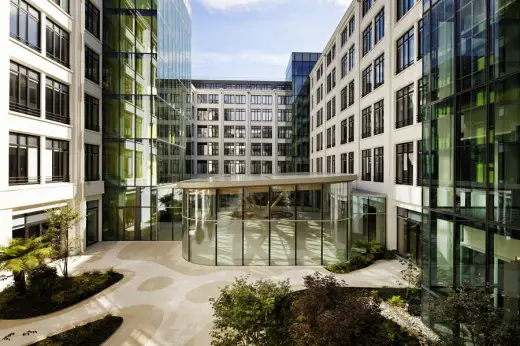
photo : Thierry Lewenberg-Sturm
A dynamic shape, symbol of an avant-garde building
How can workspaces in big companies be improved?
What is missing?
This interrogation has guided the design of the amenities wing.
Agence Jouin Manku decided to create a very different atmosphere to complement the ‘Bocage’ building. This gives employees a healthy balance between formal and informal, as well as between work and play, an idea at the heart of the In/Out Campus.
The structure of the ‘Bocage’ building evokes nostalgia, professionalism and rigor. In contrast, the new wing has been conceived as a building of contemporary architecture, designed around the idea of movement and flow. Its shape has been made to create a series of intertwined spaces. The building is organized around the idea of passage: passing of people, light and air. It is also a place which evokes movement, production, action and dynamism.
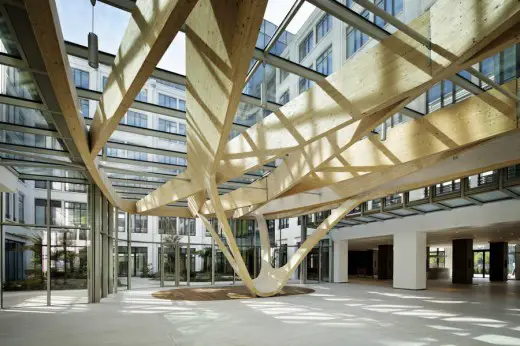
photo : Thierry Lewenberg-Sturm
The concrete heart: the center of the building
The building is organized around a central tower, made of bush hammered concrete, which holds all vertical circulation. The choice to use concrete for the center of the building was to create a coherence and dialogue with the neighboring ‘Bocage’ building, which is made of the same material and clearly shows its original industrial character.
Two wings revolve and wrap around the central tower, but they never meet. Their architectural lines are softer and each wing is a curved form, made of curved glass and vertical wood cladding. The spaces between the concrete center and the wood wings are filled with glass, which allows light to penetrate almost everywhere in the building, vertically or horizontally. On the outside, the density of the vertical
wood cladding increases and decreases, depending on its position, and which indoor space it corresponds to. The pattern starts out smoothly, then its texture, created by adding chamfers, changes. These edges catch light differently and create a sense of depth on the façade.
Inside, the main materials are wood, bush hammered concrete, plaster and curved glass. The curved wood that wraps a large part of the interior adds to the sense of warmth, while the simple use of glass and concrete add a crisp modernity to the project.
A footbridge connects the two buildings. This bridge, made of white painted steel and wood, makes access easy between the two buildings, and acts as a symbolic link between the two architectural signatures, and the birth of a common project.
photos : Thierry Lewenberg-Sturm
The « Bocage » historical building: a landmark of industry, between restructuring and construction.
DTACC architecture has chosen to focus on the historical building « BOCAGE » by designing a landscape and garden, in collaboration with landscape designer Pascal GASQUET.
A gentle slope now replaces the former parking access ramp.
The access and entrance to the building are then in harmony with the whole site, and ensure accessibility to people with disabilities.
The new amenities wing, designed by Agence Jouin Manku, has replaced the parking and now stands at the heart of the landscaped garden.
DTACC has chosen to remove the original partial glass roof that once fully enclosed the central courtyard of the historical building, to create an open air garden. The new Glass canopy in the central courtyard, designed by Jouin Manku, creates a natural transition between the lobby of the historical building and the amenities wing.
The organization and structure of the various spaces, the choice of the different scales, as well as the harmony between mineral and natural elements, give the place its « campus » touch, sought by SFL.
Restructuring the « Bocage » building
DTACC architecture
How can a landmark of the industrial landscape of the 1930s, with its historical and architectural identity, be in keeping with the 21st century?
How to create a special work environment, which will have more to offer than any other office building?
DTACC provided original answers to these major interrogations.
From the first sketches, DTACC identified the unique possibilities of this historical site. The agency succeeded in transforming the site, while both respecting its original architectural identity and introducing contemporary elements. The DTACC project reflects all the major stakes of the contemporary use of such a building.
IN / OUT Boulogne-Billancourt Paris – Building Information
Location: Boulogne-Billancourt, Paris
Client: Société Foncière Lyonnaise – www.fonciere-lyonnaise.com
Architects: DTACC and Agence Jouin Manku
Agence Jouin Manku is an interior design firm which collaborated with DTACC in designing different elements of the IN OUT project.
Agence JOUIN MANKU does not have an Architect’s “title” or “accreditation” in France and are not, as they say themselves, registered in the French Order of Architects
Photographer: Thierry Lewenberg-Sturm
Graphic artist: Édouard Memponte – www.memponte.fr
Engineers: TESS
Architect of record: DTACC
entreprise générale: Bouygues Batiment
Lighting designer: ACL
Landscape designer: Pascal GASQUET
IN / OUT Boulogne-Billancourt Paris images / information received 291113
Location: Boulogne-Billancourt, Paris, France
New Paris Architecture
Contemporary Paris Architecture
Paris Building Designs – chronological list
Paris Architectural Tours by e-architect
DTACC
For more than 45 years, DTACC architecture has been developing original and creative projects, promoting and preserving real estate through rehabilitations, hotel constructions or urban restructuring.
Managed by Jacques Cholet and Georges Carvunis, who now work with a new generation of partners , DTACC is a leader in building rehabilitations, and has developed numerous major projects in France.
DTACC mainly works in the private sector and has developed projects for offices, head offices, hotels, housing and urban amenities.
DTACC is well known for its management of « sensitive and complex » projects. They combine leading-edge technology and preservation of architecture, always keeping in mind the future evolution of the city.
www.dtacc.com
Agence Jouin Manku
Associated to great names for outstanding projects, such as Alain Ducasse, Pierre Hermé, Thierry Marx or Van Cleef & Arpels, Patrick Jouin and Sanjit Manku write together a creative dialectic, dedicated to the development of architectural concepts. Should it be for restaurants (at the Eiffel Tower or the Plaza Athénée in Paris), a private house in Kuala Lumpur or the IN/OUT campus in Boulogne- Billancourt, Patrick Jouin and Sanjit Manku invent a new language, where their common inspirations meet.
www.jouinmanku.com
Charenton-Bercy District Masterplan and Tower
Architects: SOM
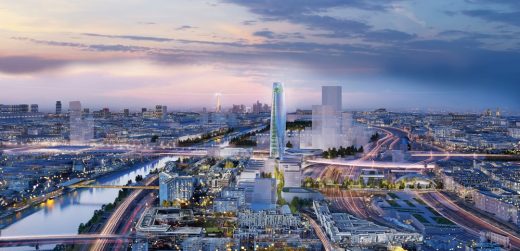
image © SOM-Ateliers2-3-4-AREP
Charenton-Bercy District Masterplan and Tower
Gaité Montparnasse, Les Ateliers Gaité, 14th arrondissement
Architects: MVRDV
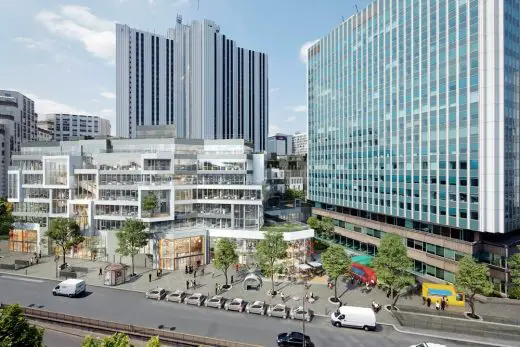
image © L’Autre Image
Gaité Montparnasse
Comments / photos for the IN / OUT Boulogne-Billancourt Paris Architecture page welcome

